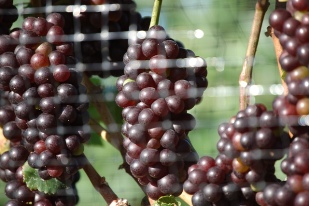|
Merlot Popularity Growth Second to None...Merlot is a red wine grape that is used as both a blending grape and for varietal wines. The name is thought to derive from the Old French word for young blackbird. This red wine grape is a diminutive of merle, the blackbird (Turdus merula), probably from the color of the grape. Merlot-based wines usually have medium body with hints of berry, plum, and currant. Its softness and "fleshiness", combined with its earlier ripening, makes this red grape a popular grape for blending with the sterner, later-ripening Cabernet Sauvignon, which tends to be higher in tannin. Along with Cabernet Sauvignon, Cabernet Franc, Malbec and Petit Verdot, This red wine is one of the primary grapes in Bordeaux wine where it is the most widely planted grape. It is also one of the most popular red wine varietals in many markets. This flexibility has helped to make it one of the world's most planted grape varieties. As of 2004, this red wine grape was estimated to be the third most grown variety at 260,000 hectares (640,000 acres) globally, with an increasing trend. This puts it just behind Cabernet Sauvignon's 262,000 hectares (650,000 acres).
Researchers at University of California, Davis believe that this red wine grape is an offspring of Cabernet Franc and is a sibling of Carménère and Cabernet Sauvignon. The earliest recorded mention of Merlot was in the notes of a local Bordeaux official who in 1784 labeled wine made from the grape in the Libournais region as one of the area's best. The name comes from the Occitan word "merlot", which means "young blackbird" ("merle" is the French word for several kinds of thrushes, including blackbirds); the naming came either because of the grape's beautiful dark-blue color, or due to blackbirds' fondness for grapes. By the 19th century it was being regularly planted in the Médoc on the "Left Bank" of the Gironde. After a series of setbacks that includes a severe frost in 1956 and several vintages in the 1960s lost to rot, French authorities in Bordeaux banned new plantings of the red grape vines between 1970 and 1975. It was first recorded in Italy around Venice under the synonym Bordò in 1855. The grape was introduced to the Swiss, from Bordeaux, sometime in the 19th century and was recorded in the Swiss canton of Ticino between 1905 and 1910. In the 1990s, this red wine saw an upswing of popularity in the United States. Red wine consumption, in general, increased in the US following the airing of the 60 Minutes report on the French Paradox and the potential health benefits of wine and the chemical resveratrol. The popularity of this red wine stemmed in part from the relative ease in pronouncing the name of the wine as well as its softer, fruity profile that made it more approachable to some wine drinkers.
Merlot grapes are identified by their loose bunches of large berries. The color has less of a blue/black hue than Cabernet Sauvignon grapes and with a thinner skin and fewer tannins. Also compared to Cabernet, Merlot grapes tend to have a higher sugar content and lower malic acid. This red grape thrives in cold soil, particularly ferrous clay. The vine tends to bud early which gives it some risk to cold frost and its thin skin increases its susceptibility to rot. If bad weather occurs during flowering, this vine is prone to develop coulure. It normally ripens up to two weeks earlier than Cabernet Sauvignon. Water stress is important to the vine with it thriving in well drained soil more so than at base of a slope. Pruning is a major component to the quality of the wine that is produced. Wine consultant Michel Rolland is a major proponent for reducing the yields of this red grape to improve quality. The age of the vine is also important, with older vines contributing character to the resulting wine. A characteristic of this red wine grape is the propensity to quickly overripen once it hits its initial ripeness level, sometimes in a matter of a few days. There are two schools of thought on the right time to harvest this red grape. The wine makers of Château Pétrus favor early picking to best maintain the wine's acidity and finesse as well as its potential for aging. Others, such as Rolland, favor late picking and the added fruit body that comes with a little bit of over-ripeness.
As a varietal wine, Merlot can make soft, velvety wines with plum flavors. While this wines tend to mature faster than Cabernet Sauvignon, some examples can continue to develop in the bottle for decades. There are three main styles of Merlot-a soft, fruity, smooth wine with very little tannins, a fruity wine with more tannic structure and, finally, a brawny, highly tannic style made in the profile of Cabernet Sauvignon. Some of the fruit notes commonly associated with Merlot include cassis, black and red cherries, blackberry, blueberry, boysenberry, mulberry, ollalieberry and plum. Vegetable and earthy notes include black and green olives, cola nut, bell pepper, fennel, humus, leather, mushrooms, rhubarb and tobacco. Floral and herbal notes commonly associated with this red wine include green and black tea, eucalyptus, laurel, mint, oregano, pine, rosemary, sage, sarsaparilla and thyme. When it has spent significant time in oak, the wine may show notes of caramel, chocolate, coconut, coffee bean, dill weed, mocha, molasses, smoke, vanilla and walnut.
|
Sign up for weekly Red Wine Reviews
CLICK HEREWe will send you the extremely popular Red-Wine-Home tasting terms when you sign-up.







